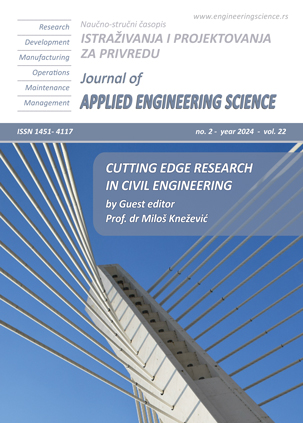DEVELOPMENT OF A METHOD FOR DETERMINING THE PARAMETERS OF ENERGY STORAGE DEVICES TO ENSURE UNINTERRUPTED POWER SUPPLY FOR AUXILIARY NEEDS OF AN ELECTRIC TRAIN
Abstract
The aim of this article is to conduct experimental research to determine the energy storage parameters for providing uninterrupted power supply to the auxiliary needs of electric trains. Analytical power calculations for the auxiliary equipment of electric trains were performed based on the operating manual data. Additionally, a statistical method of data processing on the energy consumption of electric trains was applied. The operational fleet and service routes of the motor wagon depot TCh-31 Omsk and OAO "Omsk-Prigorod" of the West Siberian Railway were examined. The ED4M series electric trains were selected for analysis, as they are the most common in the TCh-31 Omsk depot. The auxiliary equipment of ED4M electric trains was investigated, and the nominal power values of units and devices providing auxiliary needs for the motor wagon rolling stock were determined. Key performance indicators of the motor wagon rolling stock were obtained on different operating sections under varying ambient temperatures, based on data from the motion and control parameter recording systems (RPDA-E). This allows for the identification of the most optimal parameters for the electric energy storage system. The developed method will enable potential manufacturers of energy storage systems to define their essential parameters, as well as assess the feasibility of their application on specific electric trains and operating sections. In summary, for the example considered in this article, it is noteworthy that the energy storage system operates in brief intervals. The average duration of the charging mode is 60 seconds, and the returned energy volume by the motor wagon rolling stock, determining the energy capacity, averages 28 kWh at a maximum power of 0.8 MW. Based on these values, it can be concluded that the recuperation energy volume and, consequently, the energy capacity of the storage system are insufficient to cover the electric energy consumption of the electric train in traction mode. Therefore, the storage system, including its use for reducing peak loads during traction mode, can be considered. It is important to note that, for providing uninterrupted power supply to the electric train's own needs throughout the entire journey, the returned electrical energy volume during regenerative braking is also insufficient. This necessitates exploring the charging of the energy storage system at the departure station or during motion from the converter of own needs at times of minimal loading.
References
Gapanovich, V. A. Epifantsev, S. N., Ovseychuk, V. A. (2012). Energy strategy and electrification of Russian railways. Eko-Press, Moscow.
Steiner, M., Klohr M., Pagiela, S. (2007). Energy Storage System with UltraCaps on board of railway vehicles. 2007 European Conference on Power Electronics and Applications, e9852437.
But, D. A., Alievsky, B. L., Mizyurin, S. R. (1991). Energy storage. Energoatomizdat, Moscow.
Vasiliev, V. A. (2010) Traction drive with capacitive energy storage. Proceedings of the All-Russian scientific and practical conference “Transport-2010,” p. 291-293.
Cheremisin, V. T. Nezevak, V. L., Shatokhin, A. P. (2013). Evaluation of the energy intensity of electric energy storage devices for electric rolling stock at the direct current landfill of railways. International Journal of Advanced Railway (The Korean Society for Urban Railway), vol. 1, no. 2, 53-56.
Istomin, S., Shtraukhman, A. (2019). Simulation model of the heating and air conditioning system of DC electric trains. E3S Web of Conferences, vol. 135, e02018, DOI: 10.1051/e3sconf/201913502018
Istomin, S. G. Yurasov, O. D. (2020). Simulation model of heating system of DC electric-multiple units. Transport Urala, vol. 4, no. 67, 75-79, DOI: 10.1051/e3sconf/201913502018
Liu, W., Deng, Q., Huang, W., Liu, R. (2011). Variation in cooling load of a moving air-conditioned train compartment under the effects of ambient conditions and body thermal storage. Applied thermal engineering, vol. 31, no. 7, 1150-1162, DOI: 10.1016/j.applthermaleng.2010.12.010
Li, W., Sun, J. (2013). Numerical simulation and analysis of transport air conditioning system integrated with passenger compartment. Applied thermal engineering, vol. 50, no. 1, 37-45, DOI:10.1016/j.applthermaleng.2012.05.030
Wang, H., Bi, H., Zhou, Y., Li, C. E. (2020). Field measurements and numerical analysis of the energy consumption of urban rail vehicle air-conditioning systems. Applied thermal engineering, vol. 177, e115497, DOI:10.1016/j.applthermaleng.2020.115497
Beusen, B., Degraeuwe, B. (2013). Energy savings in light rail through the optimization of heating and ventilation. Transportation research part d transport and environment, vol. 23, 50-54, DOI:10.1016/j.trd.2013.03.005
Barone, G., Buonomano, A., Forzano, C., Palombo, A. (2020). Enhancing trains envelope e heating, ventilation, and air conditioning systems: A new dynamic simulation approach for energy, economic, environmental impact and thermal comfort analyses. Energy, vol. 204, e117833, DOI: 10.1016/j.energy.2020.117833
Andronov, A. M., Kopytov, E. A., Gringlaz, L. Y. (2004). Probability Theory and Mathematical Statistics: Textbook for Universities. Piter, St. Petersburg.
Strizhov, V.V. (2010). Methods of choice of regression models. RAS Computing Center, Moscow.
Kobzar, A. I. (2006). Applied mathematical statistics. For engineers and scientists. FIZMATLIT, Moscow.
A.I. McLeod (2004). Statistics 259b Robust Loess: S lowess.
Maronna, A. R. (2006). Martin, V. Yohai Robust Statistics: Theory and Methods. Wiley, New Jersey.
Demikhovsky Machine-Building Plant JSC. (2008). Electric train of an ED4M model 62-301: Operating manual. Demikhovo, Demikhovsky Machine-Building Plant JSC.

